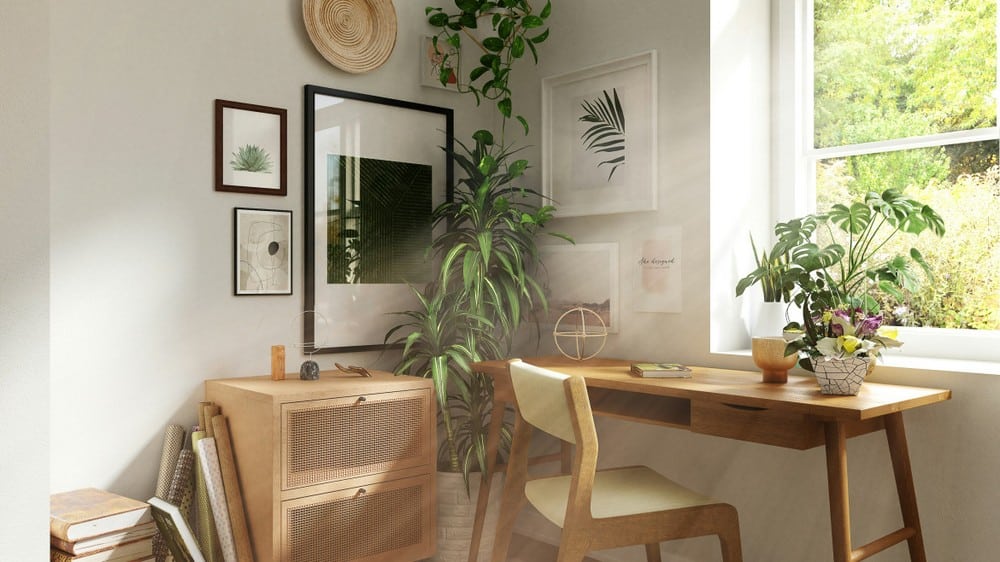
As more people embrace remote work, the home office has evolved from a simple desk in the corner to a carefully designed space that promotes both productivity and well-being. One of the most effective ways to enhance your workspace is through biophilic design – the integration of natural elements into your environment. Let’s explore how bringing nature into your home office can transform your workday and boost your effectiveness.
The Science Behind Biophilic Design
You might be wondering why natural elements matter in a workspace. Research shows that incorporating nature into our work environment can reduce stress, increase creativity, and improve concentration by up to 15%. Biophilic design isn’t just about adding a plant or two; it’s a comprehensive approach that connects us with nature, even when we’re indoors.
Maximizing Natural Light
The foundation of any nature-inspired office starts with natural light. Position your desk to face or sit perpendicular to windows, allowing sunlight to illuminate your workspace without creating screen glare. If your office has limited windows, strategic mirror placement can help bounce light throughout the room. Consider using light, neutral paint colors that reflect rather than absorb sunlight. Sheer curtains or adjustable blinds can help manage light throughout the day while maintaining that crucial connection to the outdoors.
Living Elements: Fresh Flowers vs. Plants
Fresh flowers bring immediate life and energy to any workspace. Setting up a regular flower delivery schedule ensures your office always has a touch of natural beauty. Weekly or bi-weekly deliveries can be coordinated with your work schedule, making it effortless to maintain this burst of nature in your space. Choose flowers known for their longevity, such as chrysanthemums, carnations, or orchids, to maximize the impact of each delivery.
While fresh flowers make a stunning impact, incorporating some low-maintenance plants provides lasting greenery. Snake plants, ZZ plants, and pothos are excellent choices for busy professionals. These hardy specimens thrive in various light conditions and can go days between watering sessions. Unlike fresh flowers, they require minimal upkeep while still providing the benefits of natural elements in your workspace.
Sound Elements of Biophilic Design
While visual natural elements often take center stage in office design, the acoustic environment plays an equally crucial role in creating a productive workspace. Natural sounds can mask distracting noise, reduce stress, and enhance focus – completing the biophilic experience in your home office.
Natural Water Features
Adding a small water feature to your office creates both visual interest and soothing background sound. Desktop fountains are particularly effective, as the gentle sound of flowing water helps mask irregular noises that can break concentration. Choose a fountain with adjustable flow settings to control sound levels throughout the day. For a more subtle approach, consider a small bubble wall or a hanging water feature that can double as a room divider.
Plants for Acoustic Management
Strategic placement of plants can significantly improve your office acoustics. Large-leafed plants like peace lilies, rubber plants, and fiddle leaf figs are particularly effective at absorbing and diffusing sound waves. Position these plants in corners and along walls where sound tends to bounce. Creating a small “green wall” with multiple plants can help reduce echo and absorb ambient noise from adjacent rooms or outside traffic.
DIY Natural Sound Solutions
You don’t need expensive equipment to bring natural sounds into your workspace. Consider these DIY solutions:
- Create a rain stick from bamboo or hollow tubes filled with natural materials
- Build a small rock fountain using a submersible pump and natural stones
- Design a wind chime using bamboo or wooden elements for a softer sound
- Set up a natural reed diffuser that provides both gentle movement and subtle sound
Integrating Nature Sounds into Your Work Routine
Beyond physical sound elements, you can incorporate natural sounds strategically throughout your workday:
Start your morning with gentle bird songs to ease into work mode. During focused work sessions, use rainfall or forest sounds as background noise. For breaks, switch to ocean waves or flowing stream sounds to help reset your mind. Many professionals find that matching natural sounds to specific tasks helps create productive work patterns – for instance, using morning birdsong for creative work and steady rainfall for analytical tasks.
Consider creating a sound schedule that aligns with your work patterns:
- Morning: Light nature sounds (birds, gentle breeze)
- Focus periods: White noise-like natural sounds (steady rainfall, stream flow)
- Break times: Energizing nature sounds (ocean waves, summer meadow)
- End of day: Calming sounds (evening crickets, soft wind)
Remember that sound elements should enhance, not dominate, your workspace. Adjust volume levels so that natural sounds remain in the background, providing gentle acoustic support rather than becoming a distraction. As with all elements of biophilic design, the key is finding the right balance for your personal work style and preferences.
DIY Natural Integration Projects
Transform your desk organization by creating custom pieces that accommodate both office supplies and natural elements. A simple weekend project could involve building a combination vase and pen holder using bamboo or reclaimed wood. Consider creating floating shelves with built-in planters to maximize vertical space while adding greenery at eye level.
For a more ambitious project, install a living wall grid system. This can be as simple as mounting a wire grid with attached planters or as complex as a full hydroponic system. The key is to choose a scale that matches your maintenance capacity while making a significant visual impact.
Success with biophilic design depends on consistent maintenance. Fresh flowers typically need water changes every 2-3 days, along with regular trimming to extend their life. For plants, establish a weekly care routine that includes checking soil moisture, dusting leaves, and rotating pots for even growth. Keep a simple calendar to track care schedules and delivery dates.
You don’t need to break the bank to incorporate natural elements. Start small with one or two key pieces and gradually expand. Many flower delivery services offer subscription discounts, making regular fresh flowers more affordable than you might expect. DIY projects can significantly reduce costs while allowing you to customize solutions for your space.
Overcoming Common Challenges
Limited space? Focus on vertical solutions and dual-purpose items. For those with allergies, consider low-allergen plants like snake plants or peace lilies. Time management concerns can be addressed through low-maintenance plant selection and automated watering systems. Climate control issues can be mitigated by choosing hardy species that tolerate temperature fluctuations.
Pay attention to how your new environment affects your work. Many people report improved focus, reduced stress, and increased creativity after incorporating natural elements. Track your productivity levels and well-being, adjusting your setup as needed. Simple metrics like task completion rates or stress levels can help quantify the impact of your biophilic office design.
Taking Action
Start transforming your home office today by choosing one element to implement. Whether it’s optimizing natural light, setting up a flower delivery schedule, or tackling a DIY project, each step brings you closer to a more productive and enjoyable workspace. Remember, the goal is to create an environment that supports both your work and your well-being.
The beauty of biophilic design lies in its flexibility – you can adapt these principles to any space, budget, or lifestyle. As you develop your nature-inspired office, you’ll discover what works best for you, creating a personalized environment that enhances both your productivity and your connection to the natural world.








